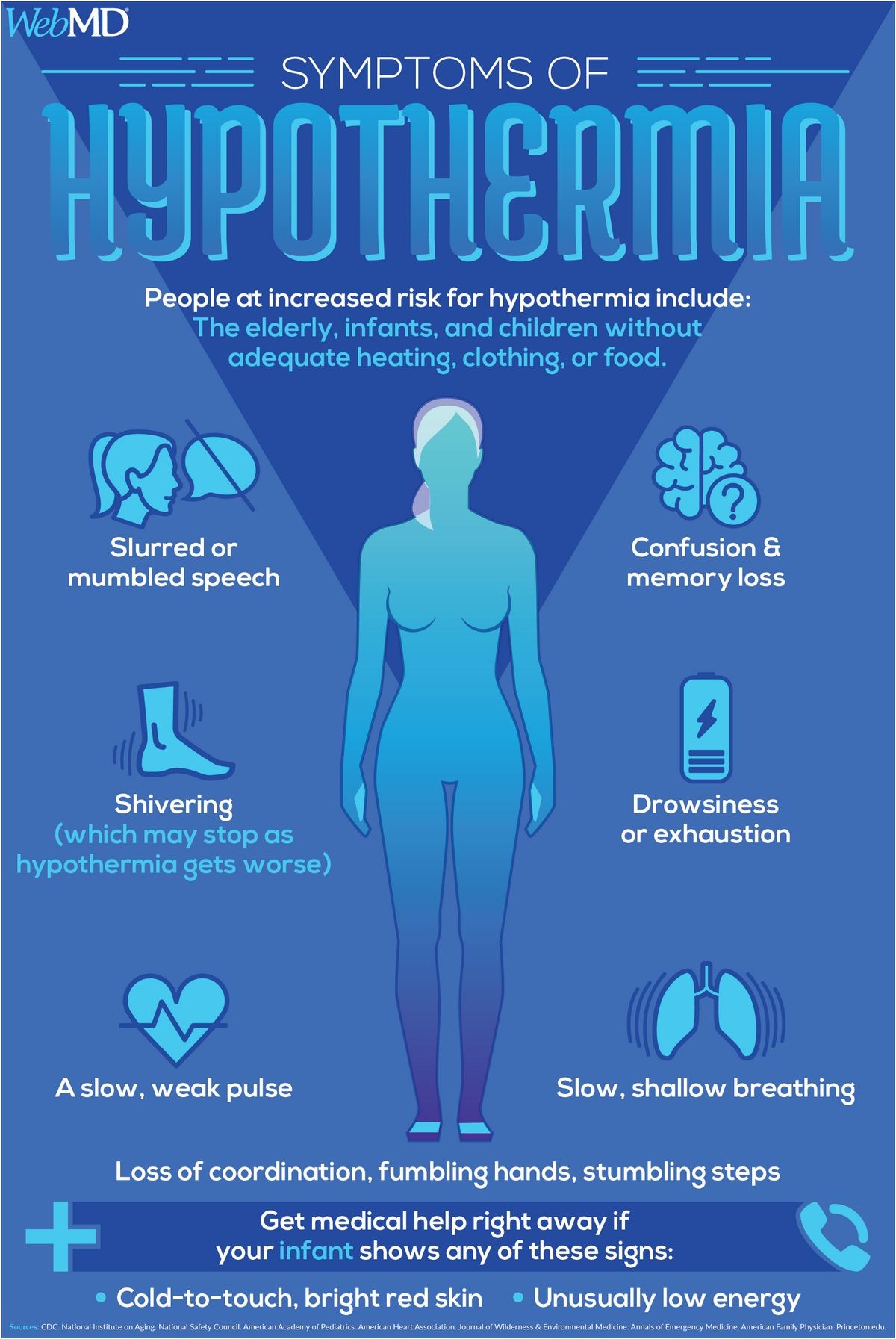
Contents
- 1 Hypothermia: Extensive Exposure to Cold
- 1.0.1 Causes and Risk Factors for Hypothermia
- 1.0.2 Signs and Symptoms of Hypothermia
- 1.0.3 Body Parts Susceptible to Hypothermia
- 1.0.4 Symptoms of Hypothermia in Infants and Children
- 1.0.5 Diagnosis of Hypothermia
- 1.0.6 When to Seek Medical Assistance for Hypothermia
- 1.0.7 Treatment for Hypothermia
- 1.0.8 Subscribe to MedicineNet’s Skin Care & Conditions Newsletter
- 1.0.9 Home Remedies for Hypothermia
- 1.0.10 Prognosis for Hypothermia
- 1.0.11 Essential Items for Hypothermia Preparedness
Hypothermia: Extensive Exposure to Cold
Hypothermia is when the body’s temperature regulation is overwhelmed by a cold environment, resulting in a core body temperature below 95°F (35°C).
The normal core body temperature ranges from 97.5°F to 99.5°F (36.5°C to 37.5°C).
Core body temperature refers to the temperature of the internal organs, such as the heart, liver, brain, and blood. It is commonly measured using a rectal thermometer. Continuous measurement can also be done with a rectal probe, or a thermometer placed in the bladder or esophagus.
A balance between heat generation and heat loss to the environment is crucial. The body loses heat in various ways, with conduction heat loss being the most common cause of accidental hypothermia, where heat is lost directly to the air or water.
Causes and Risk Factors for Hypothermia
The body regulates its core temperature in the cold through two methods:
- Generating heat by shivering and increasing metabolic rate through adrenalin (epinephrine) or thyroxine in the bloodstream
- Heat conservation by narrowing blood vessels to decrease blood flow to the skin, preventing heat loss while keeping vital organs warm
The most common situations leading to hypothermia are exposure to cold weather or immersion in cold water.
- Failing to dress appropriately for cold weather with prolonged time exposure
- Falling into cold water, such as from a boat or through ice into a pond, lake, or stream
Risk factors for developing hypothermia include:
- Elderly individuals due to lack of heat generation reserve, underlying medical conditions, and medications
- Infants and children who have limited heat generating capacity
- People with mental illness
- People with alcohol or drug problems
- Socially isolated individuals
- Use of certain medications, including beta blockers and antidepressants
Medical conditions that can affect the body’s ability to regulate temperature include diabetes, spinal cord injuries, burns, hypothyroidism, Parkinson’s disease, and malnutrition.
Signs and Symptoms of Hypothermia
As the body cools, the symptoms of hypothermia become more pronounced and severe, with the level of severity depending on the core temperature.
Mild hypothermia symptoms: core temperature of 90°F to 95°F (32°C to 35°C)
- Shivering
- Fatigue
- Increased respiratory and pulse rates
- Mild confusion and impaired judgment
- Difficulty with speech and coordination
- Cold diuresis: increased urine production due to shunting of blood to core organs
Moderate hypothermia: core temperature of 82°F to 90°F (28°C to 32°C)
- Decreased organ function, including the heart, kidneys, and brain
- Slowed heart rate and potential heart rhythm abnormalities, such as atrial fibrillation
- Slowed respiratory rate
- Decreased brain function
- Paradoxical undressing, where the victim removes their clothes
- Cease of shivering as the victim gets colder
Severe hypothermia: core temperature below 82°F (28°C)
- Coma
- Dilated pupils and loss of reflexes
- Decreased blood pressure and heart rate
- Lethal heart rhythms, such as ventricular fibrillation and asystole
Body Parts Susceptible to Hypothermia
The body parts farthest from the center of the body, including the fingers, toes, ears, and nose, are more vulnerable to cold injury and frostbite. This susceptibility is heightened in patients with peripheral vascular disease and poor circulation.
The extremities tend to cool faster than the body’s core.
Symptoms of Hypothermia in Infants and Children
Newborns, infants, and young children are at higher risk of losing body heat faster due to their larger surface area relative to body weight. Combined with their limited ability to generate heat by shivering, they are more susceptible to hypothermia.
The symptoms associated with hypothermia severity are similar to those in adults.
In mild hypothermia, infants and children may develop intense peripheral vasoconstriction, causing cyanosis or bluish discoloration. Other symptoms include shivering, rapid heart rate, rapid breathing, and awakeness.
In moderate hypothermia, shivering stops, consciousness decreases, and symptoms may include confusion, slurred speech, and a weak cry.
In severe hypothermia, brain function is lost, resulting in coma, absent reflexes, lethal cardiac rhythms, and muscle rigidity that can be mistaken for the freezing of muscles.
While severe hypothermia is often fatal in adults, infants and children have a better prognosis, especially when hypothermia is caused by water immersion.
Diagnosis of Hypothermia
A hypothermia diagnosis is typically made through patient history, physical examination, and measurement of the core body temperature.
Hypothermia is a medical emergency, and diagnosis and treatment often begin simultaneously at the scene. First responders and paramedics provide immediate resuscitation and begin warming the victim while assessing the severity of their condition.
When to Seek Medical Assistance for Hypothermia
Hypothermia can be life-threatening. If a victim is not fully awake and functional after cold exposure or belongs to a high-risk group, such as the young or elderly, it is crucial to call for help and activate emergency medical services (call 911).
Treatment for Hypothermia
The initial steps in treating a hypothermic victim involve moving them to a warm environment, removing wet clothing, and starting the warming process. Warm or insulated blankets are helpful, while rubbing the skin is not advised as it may cause damage.
For severe cases of hypothermia, treatment must be gentle due to the risk of lethal heart rhythms like ventricular fibrillation.
It is important to keep in mind that the victim may have other medical conditions or injuries associated with their cold exposure and hypothermia.
External rewarming should continue prior to hospital arrival. Active rewarming with warm water bottles or chemical packs can be considered by placing them on the person’s armpits, groin, and abdomen. Make sure the warm packs are not too hot to avoid burns (approximately 105.8°F or 41°C).
The emergency department has various rewarming methods that may be considered. In the hospital, the core body temperature is continuously monitored as the body is gradually rewarmed and injuries are evaluated.
For severely hypothermic patients, active internal core rewarming using machines that circulate and warm the blood, or instilling warm fluids into the chest or abdomen to raise body temperature, may be necessary.
Throughout the rewarming process, the patient is closely monitored for any complications, including heart rhythm problems or afterdrop. Afterdrop occurs when colder blood from the extremities returns to the warmer center of the body.
Subscribe to MedicineNet’s Skin Care & Conditions Newsletter
By clicking "Submit," I agree to the MedicineNet Terms and Conditions and Privacy Policy. I also understand that I may opt out of MedicineNet subscriptions at any time.
Home Remedies for Hypothermia
Prevention is the best home remedy for hypothermia. Avoid situations and conditions that can lead to hypothermia. In cold weather, limit nonessential trips, dress appropriately, and have supplies for emergencies.
If you come across someone suffering from hypothermia, call for help (911), move them to a warm environment, and check their pulse and breathing. Being trained in CPR can greatly assist the victim.
Prognosis for Hypothermia
The prognosis depends on the severity of the hypothermia and the overall health of the victim. Infants and children tend to have a better prognosis after severe hypothermia compared to adults.
If mild hypothermia is promptly treated without requiring hospitalization and has no or minimal residual problems, the prognosis is usually very good. Some patients may experience frostbite and have an increased risk of hypothermia in the future.
Patients with concurrent problems, such as the elderly, those with alcohol and drug abuse, psychiatric conditions, and homelessness, have a worse prognosis and higher mortality rate.
Essential Items for Hypothermia Preparedness
Hypothermia is preventable, and there are several steps to reduce the risk of cold-related injuries:
- Rooms should be heated to a minimum of 61°F (16°C) to decrease hypothermia risk in infants and the elderly. Keep at least one room in the house warm.
- Stay well hydrated by drinking plenty of fluids and warm beverages.
- Avoid alcohol and nicotine.
- Eat regular meals to maintain proper nourishment, as keeping warm in cold weather burns calories.
- Consult with your doctor regarding any medications that may affect your ability to maintain a normal body temperature.
When going outside:
- Dress in layers.
- Keep active but avoid excessive sweating.
- Wear a hat since around 30% of body heat can be lost through the head.
- Wear a scarf and gloves to protect from cold and avoid exposing bare skin.
- Change out of cold and wet clothes as soon as possible.


